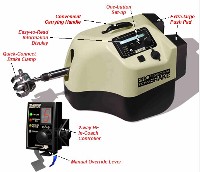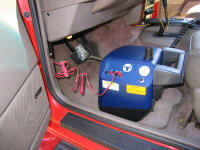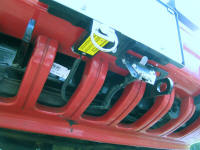
Please wait, I'm coming over...

Last Changed 3/5/2017 |
||
|
Most states are requiring some kind of brake system for trailers over a certain weight. The most popular limit is 3,000
lbs. but many
are as low as 1,500 lbs. A toad, car in tow, is considered a trailer in this case. We needed a brake system to tow
Sparky behind Tige. |
||
Some considerations about brake systems we have learnedFor the 10 years we towed Sparky and Sparky II behind Tige, the Apollo brake system worked fine for us. During this time, the 3700-5000 lbs. of the toad was attached to about 42,000 lbs. of truck and trailer. We hardly knew if the toad was attached or not. The braking power of Red Rover was more than enough and the disk brakes of Tige added to stopping power. No issues. When we changed to using the Bounder motorhome, we now had the 3700 lbs. toad behind the 22,000 lbs. motorhome. For normal stopping, the Apollo joined in when necessary. Where we found the Apollo lacking was when we were in the western mountains. The Ford transmission has a Tow-Brake mode that is similar to a Jake Brake like Red Rover had. But the almost 1/5th weight of the toad was not contributing to the downhill braking effort as downhill braking does not really trigger inertial braking that the Apollo uses to engage the brakes. This is not limited to Apollo. Virtually every auxiliary braking unit uses inertial braking. For tow vehicles with air brakes, there is an advantage of using the air of the tow vehicle to brake the toad. Many RVs do not use air brakes. We looked for an auxiliary brake unit that was triggered by the tow vehicle brakes. We really didn't find one that was reasonable. The closest thing we found is the RViBrake 3. The RVI 3 doesn't trigger off of the tow vehicle brakes but it does have a remote display unit that has a readily useable Test Button on the display so that you can apply the brakes in the toad when you would like them to add to the downhill braking. We will use our Apollo until it dies but when a replacement is needed, we will be getting a RViBrake 3. |
||
Built-in SystemsBuild-in systems are permanently mounted in the toad. One advantage is that since the system in built-in, there is nothing to store when you are not towing. These systems generally apply the toad brakes when they receive a braking signal from the tow vehicle. |
||
 |
Here is the RoadMaster BrakeMaster actuator. It is slipped onto the brake pedal and receives air pressure from a controller to extend the piston to apply the toad brakes. | |
 |
This is the MountainMaster
actuator that is similar to the RoadMaster. Another style we saw added an actuator to the toad brake master cylinder. |
|
click on images to enlarge |
||
 |
This is the
US
Gear Unified System
actuator that is mounted under the seat and uses a cable to activate
the brake pedal. Another style we saw added an actuator to the toad brake master cylinder. |
|
 |
This is the
SMI DUO
actuator and control unit..This system uses air pressure and vacuum boost to actuate the brakes.
This is a self contained system in that it does not need a brake controller to operate. |
|
click on images to enlarge |
||
Self-contained SystemsThese Self-contained systems require the least modifications to the toad. Self-contained systems are placed between the drivers seat and the brake pedal. The system uses inertial sensing to apply brakes when the system senses the deceleration of the tow vehicle. These systems have built-in air compressors that buildup pressure that is used to apply the toad brakes. |
||
 |
This is the BrakeBuddy. This is a self contained system
that has it's own air compressor and engages the toad brakes when the system senses deceleration because the tow vehicle is stopping.
There is little modification to the toad like the actuator based systems. The BrakeBuddy uses a compressor for air pressure to actuate the brakes. |
|
 |
This is the
D-Brake Professional TowBrake
system. It is similar to the Brake Buddy. Here you see the main plus the break-away switch and remote
braking control and indicator units. This system uses an electrical actuator with a built-in battery instead of air pressure from a built-in compressor. |
|
 |
This is the Blue Ox Patriot system. It looks like the D-Brake Professional TowBrake, because it is. | |
 |
This is the Blue Ox Apollo system. This was the predecessor to the Blue=OX Patriot. It is similar to the Brake Buddy. Here you see the main plus the break-away switch and remote braking indicator units. system | |
click on images to enlarge |
||
 |
This is the RViBrake 3 that is an evolution of the Brake Buddy style auxiliary brake. | |
 |
This is the RViBrake 3 Command Center tablet. The tablet is used to display the status of the brake system. Of importance to us, the Brake Test button is there so you can manually activate the toad brakes when you want. | |
click on images to enlarge |
||
|
First we decided that we wanted a self-contained system. Primarily because we already are controlling a braking signal for the trailer Tige. Adding a second brake control system would have been very problematic and we were not tempted to try and connect the trailer and toad braking systems together with all the problems that could generate. Our next selection criteria was based upon the remote braking indicator system. We wanted to know when the brakes were being applied in Sparky. We wanted be sure they came on when expected and not coming on when they should not. We preferred a light over smoking tires. |
||
 |
We chose the Blue Ox Apollo over the Brake Buddy system after we inquired on the signal distance of the remote brake indicators.
Brake Buddy would only step up to 60' while Blue Ox said we had 100' to work with. Given the length of Tige
and Red Rover, we felt 60' would have been too close to the limit. Here is the Apollo system installed in Sparky. |
|
click on images to enlarge |
||
 |
One thing we had to install for the Blue Ox Apollo was the break-away switch. This mounted on the bumper and has a cable that
attaches to the tow vehicle. If the tow bar should fail and the toad falls back from the tow vehicle, the cable will pull out a plug
activating the brake system. This too is becoming a common bit of mandatory tow equipment. |
|
 |
This is the transmitter for the Remote Brake Indicator. You have to tap a wire into the brake switch that tells the transmitter that the
brakes have been applied. We use Velcro to attach the transmitter to the mirror when Sparky is being towed. |
|
click on images to enlarge |
||
 |
This is the brake indicator receiver in Red Rover. The red light comes on when the brakes are being applied in Sparky. | |
Disclaimer: The information in this site is a collection of data we derived from the vendors and from our personal experiences. This information is meant as a learning guide for you to make your own decisions Best practices and code should always be followed. The recommendations we make are from our personal experiences and we do not receive any compensation for those recommendations. |